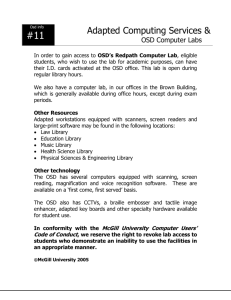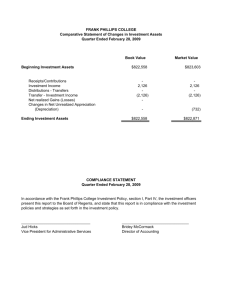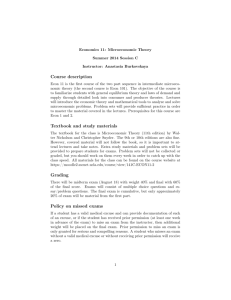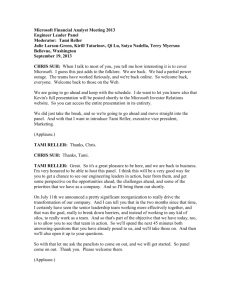09222009 Segment Reporting Changes Tami Reller
advertisement
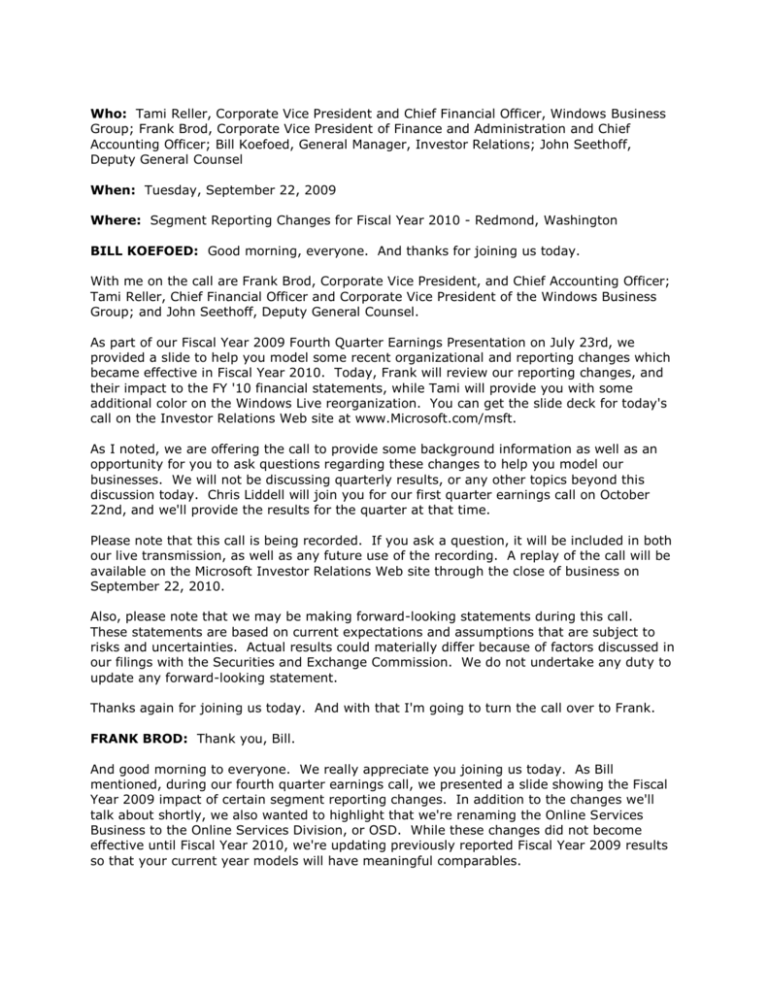
Who: Tami Reller, Corporate Vice President and Chief Financial Officer, Windows Business Group; Frank Brod, Corporate Vice President of Finance and Administration and Chief Accounting Officer; Bill Koefoed, General Manager, Investor Relations; John Seethoff, Deputy General Counsel When: Tuesday, September 22, 2009 Where: Segment Reporting Changes for Fiscal Year 2010 - Redmond, Washington BILL KOEFOED: Good morning, everyone. And thanks for joining us today. With me on the call are Frank Brod, Corporate Vice President, and Chief Accounting Officer; Tami Reller, Chief Financial Officer and Corporate Vice President of the Windows Business Group; and John Seethoff, Deputy General Counsel. As part of our Fiscal Year 2009 Fourth Quarter Earnings Presentation on July 23rd, we provided a slide to help you model some recent organizational and reporting changes which became effective in Fiscal Year 2010. Today, Frank will review our reporting changes, and their impact to the FY '10 financial statements, while Tami will provide you with some additional color on the Windows Live reorganization. You can get the slide deck for today's call on the Investor Relations Web site at www.Microsoft.com/msft. As I noted, we are offering the call to provide some background information as well as an opportunity for you to ask questions regarding these changes to help you model our businesses. We will not be discussing quarterly results, or any other topics beyond this discussion today. Chris Liddell will join you for our first quarter earnings call on October 22nd, and we'll provide the results for the quarter at that time. Please note that this call is being recorded. If you ask a question, it will be included in both our live transmission, as well as any future use of the recording. A replay of the call will be available on the Microsoft Investor Relations Web site through the close of business on September 22, 2010. Also, please note that we may be making forward-looking statements during this call. These statements are based on current expectations and assumptions that are subject to risks and uncertainties. Actual results could materially differ because of factors discussed in our filings with the Securities and Exchange Commission. We do not undertake any duty to update any forward-looking statement. Thanks again for joining us today. And with that I'm going to turn the call over to Frank. FRANK BROD: Thank you, Bill. And good morning to everyone. We really appreciate you joining us today. As Bill mentioned, during our fourth quarter earnings call, we presented a slide showing the Fiscal Year 2009 impact of certain segment reporting changes. In addition to the changes we'll talk about shortly, we also wanted to highlight that we're renaming the Online Services Business to the Online Services Division, or OSD. While these changes did not become effective until Fiscal Year 2010, we're updating previously reported Fiscal Year 2009 results so that your current year models will have meaningful comparables. It's important to note that these changes did not impact the consolidated Fiscal Year '09 results of Microsoft. Changes merely impacted the individual segment results previously recorded. The primary change was the move of Windows Live to the Client segment from OSD. This reorganization increased Fiscal Year 2009 Client revenue by approximately $520 million, with a corresponding decrease to OSD revenue. In addition, Client's 2009 operating income was reduced by $560 million, while OSD's operating loss was reduced by the same amount. Let me now turn the call over to Tami, who will provide additional color on the Windows Live move, along with the thinking behind the change. TAMI RELLER: Great. Thanks, Frank. Let me start with an overview of Windows Live, and then why it made sense to move this business to be part of the Client P&L, as Frank described. So, if I start with what Windows Live is, it is a set of applications and services, and they're all designed to make it easier for users to stay connected to people and information that are most within their inner circle. Windows Live enables communicating and sharing photos via Windows Live Messenger, or Windows Live Hotmail, and Windows Live SkyDrive is a service that delivers storage in the cloud, which allows users to access files and photos really from anywhere. The product portfolio of Windows Live also includes a set of applications that we call the Windows Live Essentials, and this includes Photo Gallery, Movie Maker, Writer, and Family Safety, and these are really examples of the ways that the Windows Live experience complements the Windows experience. A good example is Movie Maker, which has streamlined the way in which consumers can make movies on their PC. In fact, this is the scenario that has been featured in some of the Windows 7 television spots with four-year-old Kylie. I'm sure many of you have seen some of those. So, obviously, the Windows Live experience is also a key part of how we're talking about Windows 7, and launching Windows 7. And it's really this broad connection between Windows and Windows Live, this connection of simplifying your PC and tasks that matter most to our customers, that led us to bring Windows Live into the Client business. So, that's a bit about the offering. From a revenue standpoint, Windows Live primarily generates revenue from online advertising. Going forward, this will continue to be the primary revenue stream. And the drivers of this revenue continue to be a couple of key things. First is the overall growth in digital advertising. Obviously, that's key as the movement from offline to online happens. The growth of the user base as well as the engagement level of those users, and then also our ability to monetize the inventory that we create through innovations in our advertising platform. So, those continue to be the key drivers of revenue as they have been. This doesn't change as we move into the Client P&L. So, a bit more on the Windows Live business and investments. As noted in the numbers that Frank discussed, Windows Live operates at a loss with the bulk of our investments in three major areas. First, data centers that run the Windows Live Services, R&D, and innovation on the Windows Live platform, and then sales and distribution as we build out the user base and engagement of our Windows Live base. The investments in the data centers is one of the most significant investments in the Windows Live business, and really is a result of the large customer base and the strong competitive position that we have today across these services. In fact, Windows Live is number one in instant messaging, and is also number one in mail reach. To put some numbers to that, we have over 500 million Windows Live customers worldwide, and in many countries in which we operate, we are the market leader. Of note is the investments in Windows Live have not changed in this move from OSD to Client. It is an organizational move, not new or changed investment. So, going forward, our data center capacity will require investment as our users as well as the engagement of those users grow. And, these investments would have been reflected in any CAPEX estimates you would have received from Chris Liddell previously. In addition, R&D will continue to be an important investment, and we will continue to invest in distribution to ensure that we expand our user base and the engagement of those users. Windows Live is clearly strategic to the company, and strategic to Windows, and that's true both in the short-term, and to the long-term. Windows Live does further our vision to provide our customers with powerful services for both communication and sharing, and certainly delivers -- helps deliver on our software plus services strategy in a way that connects together the PC, the Web, and the cloud. With that, let me turn it back to Frank who will provide you with the details on some additional changes to our reporting. FRANK BROD: Thank you, Tami, for that insight. In addition to the Windows Live change, we've also moved our mobile services business from OSD to the Entertainment and Devices division. This reorganization increased Fiscal Year '09 Entertainment and Devices revenue by $70 million, and decreased operating income by $50 million. OSD revenue and operating loss decreased by corresponding amounts. Another change I would like to bring to your attention is a new basis for allocating certain corporate level selling costs. Historically, indirect customer field selling costs were presented as corporate level activity. We now allocate those costs, which totaled a little over $1 billion in Fiscal Year 2009, to the business groups that they support and benefit. In addition to the segment reporting changes announced in July, I also wanted to highlight two other changes. First, we're also making a presentation change related to our Media Center business. The value of our Media Center services, which totaled about $220 million in Fiscal Year 2009, will be presented as revenue adjustments rather than cost of sales. As our entertainment and devices division is compensated by the Client business group for the Media Center technology included in the Windows operating system, you will see offsetting changes in revenue and COGS in both business groups. And finally, on August 9th of this year, we announced that we had entered into a definitive agreement to divest of Razorfish, our digital advertising firm, for approximately $530 million. Prior to the sale, which is expected to close in the second quarter of this fiscal year, Razorfish was included in OSD. Pending the completion of the sale, Razorfish will be included in corporate-level activities. And in order to provide you with meaningful comparables, we have recast Fiscal Year 2009 results to reflect the same, meaning Razorfish's financial results have been moved from OSD to corporate-level activity. And with that, let me turn it back to Bill. BILL KOEFOED: Thanks, Frank. So, we hope this overview helps you better understand the financial statement impacts of these organizational and reporting changes. And we now have some time left to answer your questions. Again, please restrict your questions to items covered only in today's call. Operator, can you lead the first question. (Operator Direction.) ADAM HOLT, Morgan Stanley: Good morning, thank you. Do you expect to break out the contributions related to Yahoo on a going forward basis, and how should we think about Azure-related streams of revenue flowing through the new breakouts? Thanks. BILL KOEFOED: So, I think the answer to both of those are outside the context of what we're talking about on today's call. And I think that's a question, Adam, that you should hold on for the quarter one call, as I think some of those are a little bit premature at this point. Specifically, the Yahoo one is going through regulatory review, as you probably know. Operator, can you ask the next question. (Operator Direction.) KATHERINE EGBERT, Jefferies: Hi, thanks. Can you, for both Client and OSD, tell us how the $560 million breaks out across the operating expense category? TAMI RELLER: We're not going to provide the detailed breakout of that. But, if you look at the commentary that I provided, and let me just recap that, it gives you a good sense of where the items are. Obviously, data center costs would fall into COGS, and that is a sizable portion of the investment. Sales and distribution would be the next category that I would describe, and that would be split between sales and marketing category, as well as some into COGS, then obviously R&D, much more traditional investment there. KATHERINE EGBERT: Okay. Thanks, Tami. TAMI RELLER: You bet, thanks. (Operator Direction.) SARAH FRIAR, Goldman Sachs: Thanks a lot, just a very quick one. Is there the same deferral on Windows Live that we get with Windows 7, kind of pre the roll out, that continues. Should we be thinking along the same lines of Windows 7, or it just comes in as a piece, and it gets recognized as normal? TAMI RELLER: Yes, fair clarification. It is not included in that same program. SARAH FRIAR: Okay, great. Thank you. (Operator Direction.) WALTER PRITCHARD, Cowan & Company: Hi, it's Walter Pritchard here with Ken. Just one clarification on -- or I guess how this may change any go to market activity around Windows Live. It sounds like as it moves closer into the Windows business, is there any change with Windows 7 rollout in terms of bringing some of those services to market, or is this merely to reflect financial reporting, and no change there? TAMI RELLER: Yes, it really is primarily a change in the financial reporting to reflect where we see the synergies and the value going forward. There still will be a very close relationship, as there always is, across many business groups at Microsoft, but there still will be a close relationship between Windows Live and the other online advertising work that we do in the online services group. In fact, we share many of the same sales resources that exist in the company. And so there's a lot of shared activity, particularly between MSN and Windows Live, and that will continue. Having said that, I would say that we're getting better and better at incorporating the full Windows story into how we talk about Windows, and in particular Windows 7. So, to your exact question of will you see more of Windows Live scenarios in our Windows marketing, the answer is progressively yes, and you've seen quite a bit already with what we've done in Windows 7. WALTER PRITCHARD: Thanks a lot. (Operator Direction.) BILL KOEFOED: Great. Well, then thanks everybody. We're going to wrap this call up. And again, hopefully you found it helpful, and you'll be able to obviously access the slides on the Microsoft investor relations Web site, and the conference call will be available for replay at that site through next year, September 22nd, 2010. Thanks again, and have a great day. END
